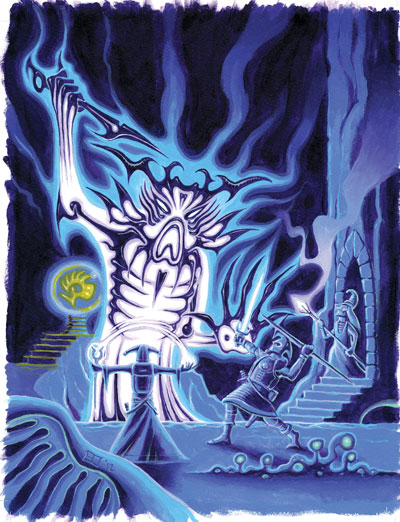12. Combat Zone

12. Combat Zone

|
|
|
|
|
|
|
|
|
|
|
|
Geography: This is
one of the most wide-open areas of
Deepearth-over three miles
wide and four miles long. Very little
of this area is filled with
rock. The combat zone was originally a
large natural cavern, but
centuries ago a cataclysmic earthquake
wreaked fearful changes
here. Somehow, a few towering blocks
of stone remained in place,
supporting a vast ceiling. Most of the
rock around the caverns
fell away into the depths of the earth,
creating a landscape that
is now treacherous and bizarre.
A dozen mighty blocks, each
hundreds of feet in diameter, support
the sagging ceiling. The
floor of the cavern is split with so
many gorges, chasms, and
cliffs that it is impossible to walk more
than 100 feet at the same
elevation. Some of these obstacles
drop or climb a mere 10
or 20 feet, while others present barriers
100 feet high (or deep).
Unlike the sunken
swamp, material and creatures from the surface
did not fall into this region.
A thriving jermalaine community
in the original cavern was
decimated, however, and the survivors
have not tried to rebuild
or re-excavate their homes. The combat
zone is connected to Areas
9 and 13 by narrow caverns. These
connecting passages were
originally natural caves, but have
been widened by the jermalaine
to allow parties of the diminutive
humanoids to pass. These
connecting passages, at their smallest,
are about three feet high
and five feet wide.
Denizens: The combat
zone gets its name from the ongoing
conflict between its two
major groups of denizens: the jermalaine
and the pech.
The jermalaine are numerous, but unorganized.
They live in a collection
of small caves among the bases of the
support pillars. While no
less malicious or vandalistic than is
usual for their race, these
jermalaine are less effective foes than
most of their kin. Perhaps
the shock of the earthquake has left a
deep impression on them,
or maybe constant setbacks in their
ongoing war with the pech
have caused their defeatist attitude. In
any event, these jermalaine
have a tendency to run from danger
long before the situation
seems to warrant retreat.
The pech inhabiting the
combat zbne, on the other hand, are a
disciplined and business-like
group. Numbering less than 100,
the pech are outnumbered
at least 10 to 1 by the jermalaine. The
latter regularly attack
the pech work parties and are routinely
driven off. The pech roam
freely throughout the vast chamber,
pulling heavy stone wagons
from one location to another in their
search for mineral wealth.
The pech use their innate wallofstone
ability to erect bridges
and ramps that enable them to pull their
wagons with them wherever
they go. When the jermalaine attack,
the pech instantly cease
working and break into combat units.
Fighting with skill and
dedication, they invariably drive off the foe
while sustaining minimal
losses.
Other denizens of the combat
zone include hordes of rats that
live among the jermalaine,
and many bats, including mobats,
which enter and leave through
unknown routes through the ceiling.
A chimera also roams among
the pillars, and several nests of
basilisks are located among
the lowest reaches of the chamber.
Resources: This huge
chamber
is well-supplied with air and
water.
Hidden passages in the lofty ceiling allow air to circulate
throughout the area. As
in the sunken swamp, water flowing on
the surface seeps through
in several locations, providing a
steady supply of water below.
Instead of falling from the ceiling as
a misty rain, however, the
water tends to run down the sides of the
massive supporting stone
columns. The sides of these columns
are cracked and rough, and
the water spills down from cracks to
ledges, creating many small
waterfalls. The sound of splashing
and flowing fills the chamber.
Small pools of fresh water have
formed at the base of many
of the pillars, but because the cavern
floor is cracked and porous,
these pools quickly drain away to
areas still deeper. No streams
flow along the bottom of the combat
zone.
The tumultuous forces of
the earthquake brought slabs of rock
from widelyvarying levels
of the earth into this chamber, and it is
this diversity that has
drawn the pech. Veins of iron, lead, and
gold are all accessible
here. In addition, the pech have excavated
small deposits of jade and
onyx. Several other types of gemstones
lie near the surface, but
have yet to be discovered.
Unique Features: The
bridges
and ramps erected by the pech
create a haphazard series
of pathways throughout the roughly
floored cavern. Most of
these are sturdy enough to serve any
creatures who use them,
but about 20% have been sabotaged by
the pech and will collapse
if anything heavier than 50 pounds
(500 gp) tries to cross
them. The pech used their skill at stonework
to chip away the bulk of
the stone bridges, leaving just a hollow
shell. Alert characters
who tap the stone before venturing
onto it will notice a hollow
sound.
In 16 different locations
throughout the chamber, the pech
have excavated small holes
in which to store their treasures.
These holes are sealed over
with wall of stone spells. The magical
stone is cleverly camouflaged
to resemble the stone natural to
the area, but nonetheless
radiates magic if in the area of a detect
magic spell. Each of these
treasure troves contains an assortment
of gems worth 2d6 x 1,000
gp, and a pile of gold coins worth
a similar amount. In addition,
hundreds of lead and iron ingots fill
each trove. The wallof stonecovering
each trove is 16 feet thick.